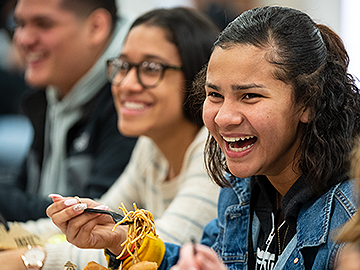The love of food is a common thread among all generations that brings a sense of belonging and togetherness — which is why school cafeterias can be wonderful platforms to encourage awareness of different flavor profiles and cuisines of other cultures.
At Sodexo, we recognize the evolving landscape of our student demographic and embrace that younger generations are more diverse than ever before. In fact, according to a recent report by Hotwire Global, 47% of children in the United States come from diverse ethnic backgrounds. This is exactly why cultural diversity in food is a core foundation of what we do. We build on our commitment to fostering warm, welcoming environments by embracing cultural diversity in school cafeterias. Including a diverse array of options that celebrate different flavors and traditions can make a lasting impact on students.
The Joy of Cultural Representation on the Plate
To ensure diversity in our menus, we leverage our regional culinary and menu network to gain information on the demographics and cultures of each school district and create recipes based on that information for our master menu plan. Then, each school can choose how, when and where they add those new recipes to their menu schedules. We want our school menus to reflect the rich tapestry of global cuisines and offer students a passport to culinary adventures, so we've developed our menus with the goal of integrating flavors inspired by local cultural groups.
Exposure to diverse flavors not only broadens students' palates but also transforms mealtime into an educational journey, promoting a deeper understanding of various cultures. In addition, witnessing one's heritage on the plate fosters a sense of belonging and pride, contributing to psychological and emotional well-being. For first-generation immigrants and refugees, this connection to familiar foods becomes a crucial bridge, breaking down barriers to not only ease the transition into a new educational environment, but also to encourage connection with peers trying these foods for the first time.
Cultural Diversity in the School Cafeterias

We’ve seen great success in integrating cultural diversity into the cafeteria — and Balsz School District in Arizona is an excellent example. As a school district that is home to a high population of Hispanic students, Balsz schools have been very successful in integrating a wide variety of Hispanic cuisine into their menus.
Additionally, we recently worked with community members in Holyoke, Massachusetts, to integrate cuisine to represent their high numbers of Puerto Rican students. Our teams collaborated with our local chefs of Puerto Rican heritage to create an array of diverse dishes, producing 15 new recipes celebrating Puerto Rican culture and history. While many students in these school districts have found familiarity in their home cuisine, studies have shown that when culturally diverse students are able to recognize foods from home in the cafeteria, their friends get excited about those foods, too.
The Challenges of Ensuring Cultural Diversity in the Cafeteria
While our menu system has been highly successful, we do acknowledge that there are still challenges to consider when creating and implementing new and diverse menus, such as dietary considerations and budget constraints. Another true challenge in creating culturally diverse meals is upholding authenticity. Because we must purchase American ingredients that are in line with child nutrition regulations, it can prove difficult at times to find specific necessary ingredients for culturally diverse meals without importing specific ingredients.
We typically work in collaboration with our local communities to brainstorm creative menu planning while maintaining adherence to child nutrition laws and purchasing guidelines. While these regulations do present challenges to being truly authentic in our recipes and menus, the goal is to try to be as inspired as possible — and through our culinary network, we are always evaluating our recipes and menus. Just last summer, we created more than 65 new culturally diverse recipes that became part of our core menu plan for the year, and we plan to continue to create new recipes each year as we consider changes in demographics and feedback to see where we can make improvements.
The Role of School Cafeterias in Promoting Cultural Awareness
School cafeterias act as the perfect catalyst for cultural education by fostering conversations about diverse cuisines. Cultural menus not only resonate with specific groups but also serve as learning opportunities for others, cultivating an inclusive environment. In addition to the creation of diverse menus, Sodexo is also proud of the diversity within our teams. Our employees maintain a deep love of food and a passion for sharing their own unique cultures with students. When these staff members get the opportunity to prepare food and serve recipes that are close to their hearts, they can take pride in sharing their own culture and traditions. This truly promotes a family atmosphere within the cafeteria environment and fosters an even greater sense of belonging.
Looking to the future, there’s lots of opportunity on the horizon for Sodexo to continue to expand this initiative in the cafeteria. For example, it is a goal to one day add additional holiday meal celebrations throughout the year as part of menu development, for which we would create diverse menus honoring global cultural holidays.
Fostering Nourished Minds and Cultural Connections
It is so important that we continue to represent the diverse cultures within our schools and create a safe space where students can really come together with their peers at the table. At Sodexo, we are committed to ensuring that our menus are inspired by the communities we serve and aim to create an environment where food becomes a source of bonding, education and comfort for students and parents alike. As we move forward, we hope to achieve a future where every meal represents a cultural celebration and where diverse flavors and traditions unite — to nourish not only bodies, but also minds and spirits.

